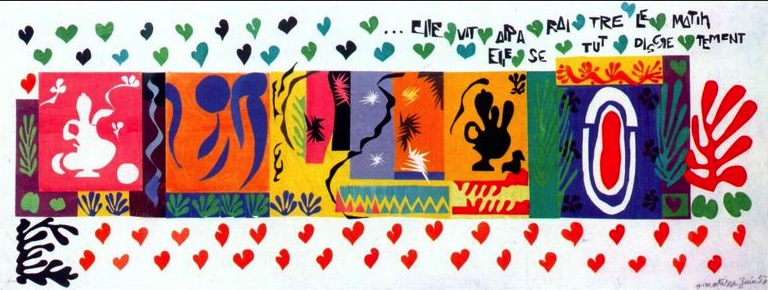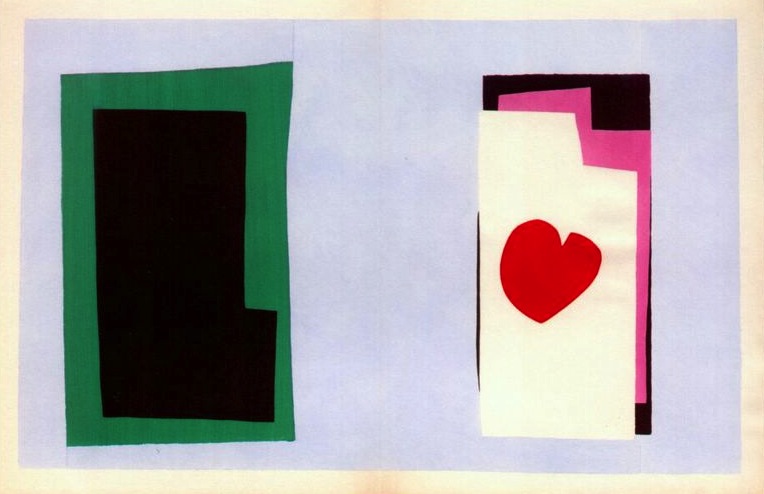Starting, unconventionally, in Pittsburgh, Richard Stemp looks forward – and back – to Matisse’s Paper Cut-Outs on display at Tate Modern, and then looks forward again to living happily ever after.
I have been to Pittsburgh four or five times, more often, in fact, than I’ve been to Boston or Washington DC, and most Americans would ask, horrified, ‘Why?!’ It still hasn’t recovered from the reputation it gained in the early 20th Century as the soot-blackened, smog-ridden steel capital of the States. But when I first went, way back in 1986 (ah, how time flies), it had just been voted America’s Most Liveable City. Andy Warhol was from Pittsburgh, as was Henry Clay Frick, a coke and steel industrialist whose vast wealth (from all that pollution) allowed him to put together one of the greatest individual art collections, the Frick, which found its home in New York and is one of the highlights of any visit to that remarkable city. Andrew Carnegie, another Steel Magnate and philanthropist from Pittsburgh, is perhaps not as well known, but you can still find Carnegie Libraries across Britain. It is intriguing to think that in the early 20th Century an American thought that the British needed to read, but he was British – a Scottish émigré, in fact, from Dunfermline. He gave his name to Pittsburgh’s wonderful Carnegie Museum of Art, well worth a visit, and home to probably my favourite work by Matisse, a paper cut-out called The Thousand and One Nights.
I know this image remarkably well. Having seen it several times in the late 1980s, it was still in my mind when I moved in the late 90s. The new flat was in the basement, and had a long, narrow room underneath the ground floor entrance, ideal as a study. At the far end was a window, perfect for a coffee table and an armchair, so I could sit and read, work and relax at the same time (Matisse once said that art should be like a comfortable armchair). I thought The Thousand and One Nights would look perfect there, and planned to write to Pittsburgh to see if they did a poster. But before I got round to writing, I was forced to go to IKEA. That’s what love does – it makes you go to IKEA. It makes you go to Pittsburgh. True love means you don’t have to do these things if you don’t want to, and, a couple of exes later, I haven’t been to either for a long time now. But this was Kismet – a perfect concept, in this context – as IKEA actually did do a poster, and it fit perfectly on the wall by the window at the end of the study for four years. And, when I moved ten years ago (exes being what they are), it found a place above my bed.
I don’t always sleep very well (though better, I’m sure, than Matisse, who suffered terribly from insomnia), but The Thousand and One Nights is the perfect companion for a sleepless night, a great tale well told. Scheherazade knows that the King, angry at the infidelity of his first wife, has killed many subsequent wives after just one night of marriage. Nevertheless, she accepts his proposal, and to save her own life she tells him a story, keeping his attention throughout the night, and leaving off half way through as dawn breaks. She lives to see the day – and to tell the rest of the tale the following night. Only she never finishes. Well, not for a thousand nights, by which time he has fallen in love with her, and from the thousand and first night, we presume, they live happily ever after. Matisse tells his tale in separate sections, using five main ‘blocks’, which he developed separately and then joined together, chapters in a story. The first, a smoking lamp, as night falls, is followed by a stylised, blue female form: Scheherazade herself, perhaps, in obeisance before the King. Flashes of stars, and leaf-like forms take us through the night, which draws to a close with another, smokeless lamp. Day has dawned. And finally, a rich, round, red oval – the rising sun? The warm heart of the story? Or something more sensually direct? And then the image opens up, a red leaf crosses from the hard edge of the last ‘block’ and brings the white background into play, an open-ended, happy ending. Red and pink hearts trail along the bottom, and along the top, black hearts, which alternate with green, trail off into words: “…she saw the dawn appearing, and discreetly fell silent”.
I’ve always loved the cut-outs, and when I heard that Tate would hold a major retrospective this year I was very happy. Even more so when I heard that the Carnegie – who don’t always display The Thousand and One Nights, paper being so fragile – are lending it to this exhibition. It was remarkable to see it, like meeting an old friend, with whom you’ve been asleep for ten years, for the first time in twenty-five. It’s far larger than I remembered, and the colours far more subtle. Its physical presence, as a made object – not a machine tooled, flat plane of colour – is also essential for its understanding. The flatness of the printed versions of his cut-outs was something that disappointed Matisse himself, even though he developed them, in part, to avoid other disappointments of printing – the subtle shifts in colour, for example, between the preparatory maquette, or model, and the finished edition.
Initially, paper cut-outs were just a tool for him. He would use them while developing other works, a form of sketching, or drawing with colour. As such it was vital for the development of his mural, The Dance, of 1932-3, for another great American entrepreneur, Albert C. Barnes: the more-or-less vertical bars of pink, blue and black relate to cut-out elements in the preparatory stages. His interest in dance led to a commission to design the ballet, Rouge et Noir, for choreographer Léonide Massine. The stage curtain design is still held together with pins, the same colour as the paper, showing how the individual elements could be moved and adjusted to find the right combination of line and colour. But it was with Jazz – undoubtedly one of the most important artist’s books of the 20th Century – that he began to realise the full possibilities of the cut-out.
Jazz is exhibited in its entirety in the Tate exhibition, and is one of the highlights. Indeed, it is exhibited twice, as the final, printed version is displayed alongside the original maquettes. Frustrated, as I have said, by the changes in colour from design to print, Matisse decided to cut into colour itself, using paper painted in exactly the same pigments as the printer’s ink. The original idea was to illustrate poems, but instead Matisse wrote notes about his ideas, his working practice and about the inspiration for the images. The text functions formally, a black and white breathing space between the brilliant intensity of the images. Already, with The Heart, we have the seed for the later tale of Scheherazade, with the same combination of black and green, pink and red, in adjacent blocks, and with the tell tale heart. This is by far one of the simplest of twenty vibrant images. It is wonderful to see them all together, and instructive, too: given the accuracy of the colour, Matisse was now disappointed by the flatness of the final image, and, of course, he was right. Side by side they are still glorious, but somehow lifeless, and later cut-outs were arranged together, loosely pinned to the wall so that cut leaves would wave in the breeze, as three-dimensional works. Different combinations of colours were tested against one another, much as Albers would focus on the square, or Riley on the line. Indeed, the undulating leaf forms so beloved of Matisse allow the maximum interaction between two different colours, in the same way that Riley uses long lines, straight or curving, to maximise the contact between the elements of her chosen palette.
Matisse used the technique to design book covers and posters, ceramic wall panels and stained glass, and even the decoration of an entire chapel (including the priest’s vestments) for the Dominican Nuns of Vence, in the South of France, one of whom had nursed him through a serious illness. But before long he realised that the paper cut-outs could be an end in themselves, they could live free of the restrictions of the canvas, and take up entire rooms. The Parakeet and the Mermaid, for example, was developed on the walls of his studio, and originally wrapped around a corner of the room, while the Oceania works developed, in part, as a way of covering marks on the dull and shabby walls of a room in Paris. As you go round this wonderful exhibition the works get steadily larger, his ideas become freer and you gradually find yourself encompassed by colour. If you do go – and you should – it will be the most positive, glorious and life-affirming thing you see this year – this decade, for that matter, or this millennium – and it will leave you happy, if not forever, at least for now.





